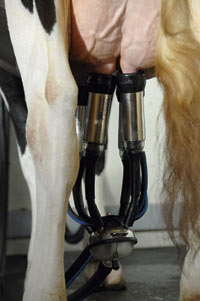Controlling somatic cell counts

Controlling and tackling somatic cell counts was high on the agenda at a recent Mastering Mastitis Masterclass held at Exeter Rugby Club by Boehringer Ingelheim.
Today’s cow with a mediocre somatic cell count (SCC) was tomorrow’s problem, said Andrew Biggs of The Vale Vet Group, Tiverton, Devon.
“Once cows have mediocre cell counts, they have the potential to move up the cell count ‘escalator’ and become your ‘millionaire’ cows.
“The trouble is farmers spend most of their time looking at the ‘millionare’ cell count cows while all the time the problem below is getting worse.”
Treating animals for SCC would prevent clinical mastitis from developing, reduce spread and reduce the “melting pot” of infection within the herd, he said.
Figures from NMR Herd Companion, covering 600,000 cows, showed 18% had cell counts of more than 200,000 cells/ml. And 80% of these were cows calving in “clean” and then picking up infection.
“About 70% of these cows started with a SCC of between 200,000 to 500,000 and 59% persisted at this level,” he said.
“A lot of your problem cows will be the ones persisting. The key is to spot when these newly infected cows first go up to 200,000 so you have the opportunity to treat before the problem worsens.”
However, the decision to treat high SCC cows would depend on individual farms. “The economics must add up,” stressed Mr Biggs.
“When you are getting your top p/litre, the only driver to address cell counts would be if mastitis was getting out of control.”
But, when infection rate went up and you were still receiving a good milk price, it might be worth heading off the problem by treating.
The only way to cover the costs of treating SCC was to get more value from your milk, he said. “If you get rewarded for addressing cell counts then it is well worth treating these cows.”
“You must judge the value of treatment. It comes down to the complexities of mastitis in the herd, the spread of disease and bulk milk somatic cell count.”
Dutch research showed there was a £55 a cow cost:benefit from treating cows with high cell counts for Strep uberis when there was a high probability of transmission within the herd. “However, when there was low probability of transmission, the cost benefit reduced to £15.”
Successful treatment would also depend on the bug involved. “Staph aureus was notoriously difficult to treat.” But, when Staph is identified as causing high herd cell counts and farmers are being penalised in terms of p/litre, it was possible to “buy time” by treating high cell count cows.
“This will reduce disease spread while the root of the problem is addressed through management and husbandry,” he says.
However, could somatic cell counts be too low? asked Andrew Bradley from Nottingham University.
“Dutch research showed low cell count herds and cows in negative energy were more prone to mastitis,” he said.
“Cows with cell counts of less then 50,000 cells/ml or more than 250,000 cells/ml were at a higher risk of developing clinical mastitis.” But, animals with cell counts of about 50,000 to 250,000 were less likely to be infected and counts of 100-150,000 were ideal.
“When you reduce bulk milk SCC you may reduce the number of cows in the high risk group, but consequently there is a shrinking number of cows in the ‘safe’ category, between about 50,000 and 250,000– it all comes down to balance.”
And when more cows were in this low cell count category, you were walking a “tight rope”. “You will need a better environment and better control of negative energy balance to mitigate risk.”
The key was to be aware of the problem, consider how to manipulate cell counts into the 50,000 to 250,000 safe category and find ways to improve immune status and reduce risk.
